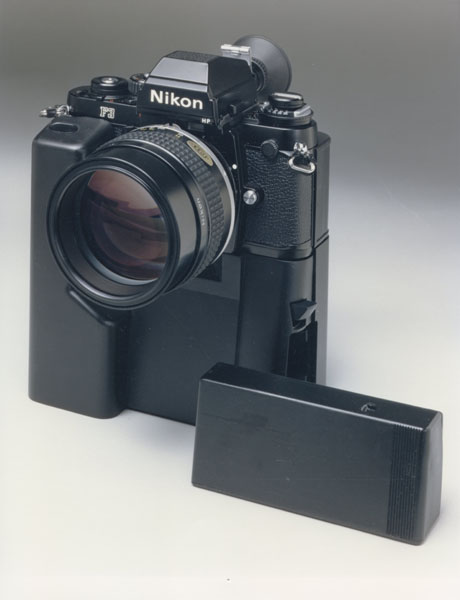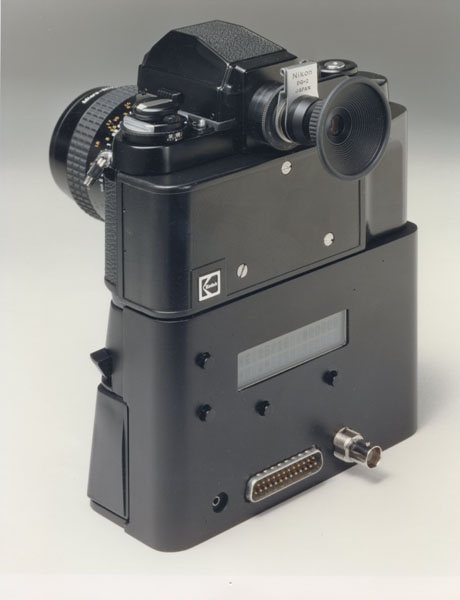

Of course, we all knew a camera shouldn't be tethered to a shoulder pack. The interest in the Tactical Camera justified a bit more investment in demo cameras. For this camera, we made printed circuit boards and packed all the electronics into a motor drive size housing under the Nikon F3 body. There wasn't room for a motor drive, so this digital camera had to be hand wound to cock the shutter! There wasn't room for a hard drive, either. Images were stored in DRAM in an Image Storage Module that plugged into the side of the camera. The ISM had its own batteries to keep the DRAM refreshed until it could be unloaded.
Power was provided by two exotic non-rechargeable lithium C-cells in the hand grip. These guys cost about $30 a cell, so this camera probably produced the world's most expensive digital camera images.
The back had the same dot matrix LCD and buttons, a BNC video output jack, and the smaller 25 pin SCSI connector, just like a Macintosh computer. The camera could capture the full resolution of 1280 x 1024, or 640 x 512 quarter size to increase ISM capacity to a whopping 16 images.
We called this the "March Camera" because the FSD marketing guys insisted we have it working by March of 1989, for some government trade show, I think. We just made it.
These pictures are of the camera in 2012. I captured them with a Kodak DCS Pro SLR/n camera - the state of our art in 2005. It's interesting to compare them to the original pictures above, which I think were taken with a 4x5 view camera. After making those 8x10 prints and scanning them 24 years later, they are still finer images than the 14 megapixel SLR/n digitals. Film was good!
The funny, oval shutter buttons were borrowed from the Kodak disc camera parts bin. This camera was saved from the dumpster by Bruce Crosman, and is now in the George Eastman House collection.
Here's the "Sell Sheet" with all the particulars. More to stir up interest - we didn't expect to sell any of this design. We assumed a real product would be designed to order. The name "Imaging Accessory" instead of "Camera" was intended to downplay the potential threat to Kodak's film business.
The camera opened up in 2012. It was a very tight fit, but it worked. Renae Sanger did the mechanical design drawings.
The stack of three main boards crammed with too many big components. Bruce Crosman and Joanne Schleyer joined the team to design these boards. Manufacturability standards were compromised a bit to make it all fit. The boards were all hand assembled by Tom McCarthy. We made four of these cameras in 1989. I kept this spare board set that was never built into a camera.
This is the Image Storage Module (ISM) opened up. The five 1-Megabyte DRAM SIPs would hold four full-res images. The battery compartment next to them held two AA non-rechargeable lithium cells. I believe they could keep the DRAM refreshed for about 24 hours.
The imager and amplifier boards in the back. The capacitor missing right in the center on the back of the CCD was shorted. After I removed it, the camera worked! The display includes a handy 8 bar histogram - my first indication that it was actually imaging...
Without some work, I couldn't get the digital images out of the camera through the SCSI port. So I took the camera upstairs to the living room and hooked the NTSC video output to the TV. The sample images here were saved to a DVD and then grabbed to JPEGs.
The 640x480 resolution is one quarter the camera's full resolution. The camera can zoom and pan for the video output, so that second shot of the apple is the zoomed center portion of the image on the left.
The CCD focus position is adjustable and is not in the right place, so I was focusing by trial and error. Peter is a little out of focus, but the bookcase is pretty close.
The CCD doesn't have an IR filter on the cover glass, as most digital camera sensor do. The luminous grass reveals the IR sensitivity. I used a hot mirror filter on the lens for the SUV.
The camera is drawing 1.5 amps during the exposure! That kind of current eats $30 batteries pretty fast. The checkerboard is the "test pattern" output on the video port when no image has been captured. It's actually the natural power up state of the DRAM.